How Far Can You Travel on Horseback in a Day?
Planning a trip on horseback is an exciting adventure. But a key question arises: how far can you travel on horseback in a day? The answer isn’t as simple as you might think. Indeed, it depends on several important factors that ensure the well-being of your equine partner.
The Short Answer: A Realistic Daily Distance
For a healthy, well-conditioned horse, a realistic distance is about 20 to 25 miles (32 to 40 kilometers) per day. This assumes a steady pace with regular breaks for rest, water, and food. This distance allows for a sustainable journey over multiple days.
However, this is just an average. Pushing a horse too hard can lead to exhaustion and injury. Therefore, understanding the variables is crucial for a safe and enjoyable journey for both rider and horse.
Key Factors That Influence Your Horse’s Travel Distance
Several elements come into play when determining your daily mileage. Consequently, you must consider each one carefully before setting out on your adventure.
Horse’s Condition and Breed
A horse’s health, age, and fitness level are the most significant factors. For instance, a fit Arabian, bred for endurance, will naturally cover more ground than a heavier draft horse. You should always assess the individual animal’s capabilities.
The Terrain
Next, think about the ground you are covering. Flat, well-maintained trails allow for faster and easier travel. In contrast, steep mountains or rocky paths will significantly slow you down. This difficult terrain requires much more energy from your horse.
The Rider’s Skill
An experienced rider knows how to balance and move with the horse’s rhythm. This skill helps conserve the animal’s energy over long distances. A novice rider, on the other hand, can inadvertently make the journey harder and more tiring for the horse.
The Weight of the Load
Finally, remember to account for the total weight your horse is carrying. This includes the rider and any gear, food, or water. A heavier load means the horse must work harder, which consequently reduces the distance it can comfortably travel in a day.
How Far Can You Travel on Horseback in a Day at Different Paces?
A horse’s speed, or gait, directly impacts daily mileage. A sustainable day of travel primarily consists of walking, with some periods of trotting on good terrain. Here’s a simple breakdown:
- Walk: A horse walks at about 4 miles per hour (6.4 km/h). A fit horse could walk for 6-7 hours a day, covering around 24-28 miles.
- Trot: A trot is faster, around 8 to 12 miles per hour (13 to 19 km/h). However, a horse cannot maintain a trot all day. It’s used for shorter periods to cover ground more quickly.
- Canter/Gallop: These are fast gaits reserved for short bursts of speed. They are not suitable for long-distance travel as they are extremely tiring.
Historical Perspective vs. Modern Reality
You might have heard stories of epic journeys covering 50 or even 100 miles in a day. While historically possible with networks of fresh horses (like the Pony Express), it is not a realistic or humane goal for a single horse. Modern riders prioritize the animal’s welfare above all else.
Planning Your Horseback Journey: Tips for Success
To ensure a safe trip for both you and your horse, keep these tips in mind. Proper planning makes the experience better for everyone.
- Plan for Breaks: Stop every hour or two. This allows your horse to rest, drink, and graze.
- Check Your Horse Regularly: Look for signs of fatigue, soreness, or dehydration throughout the day.
- Travel Light: Only pack the absolute essentials to reduce the burden on your horse.
- Listen to Your Horse: Ultimately, your horse will tell you when it has had enough. Learn to read the signs and always respect its limits.
In conclusion, traveling on horseback is a rewarding experience. By understanding the realistic goal of 20-25 miles and respecting your animal’s needs, you can create unforgettable memories on the trail. This ensures your four-legged partner stays happy and healthy throughout your adventure.



